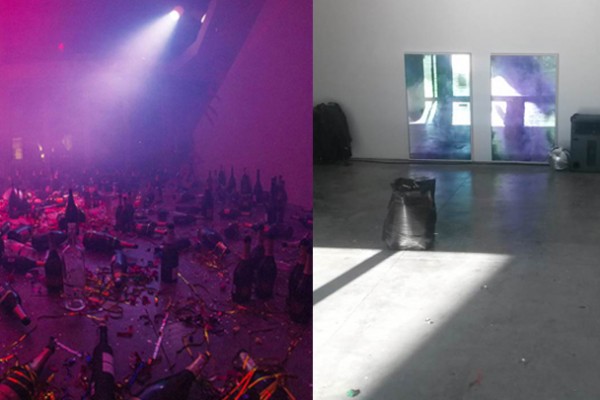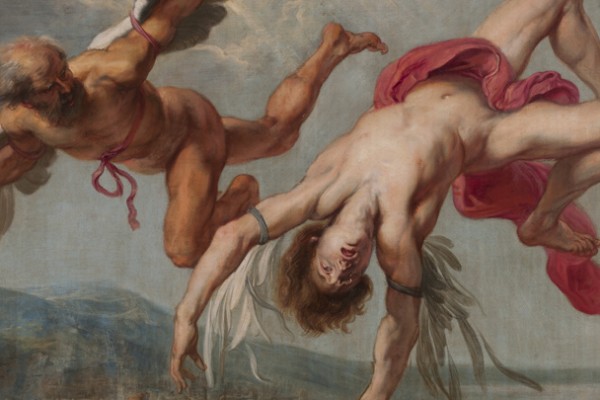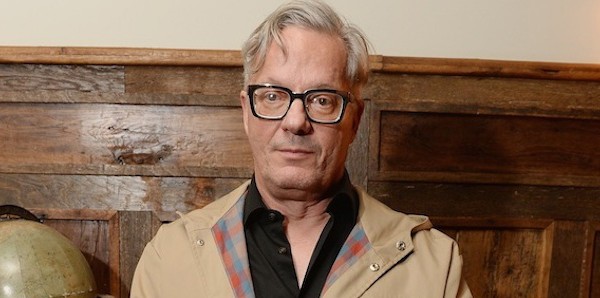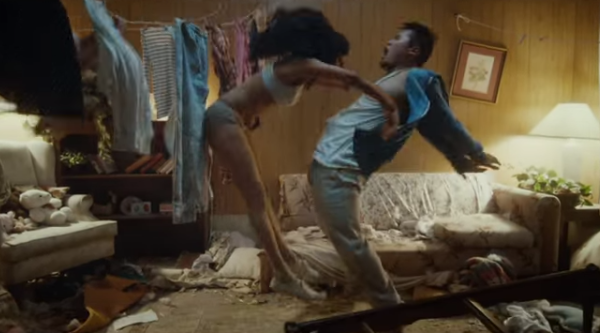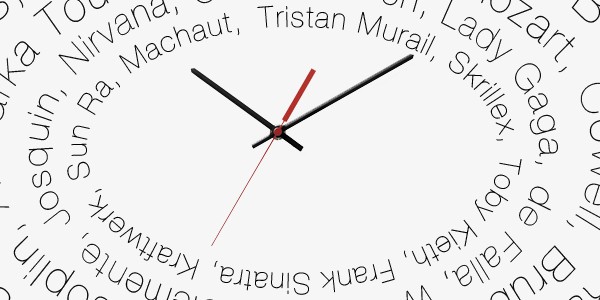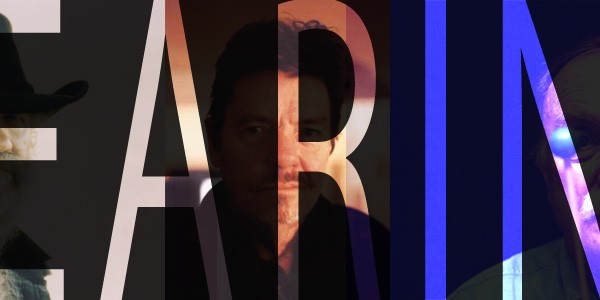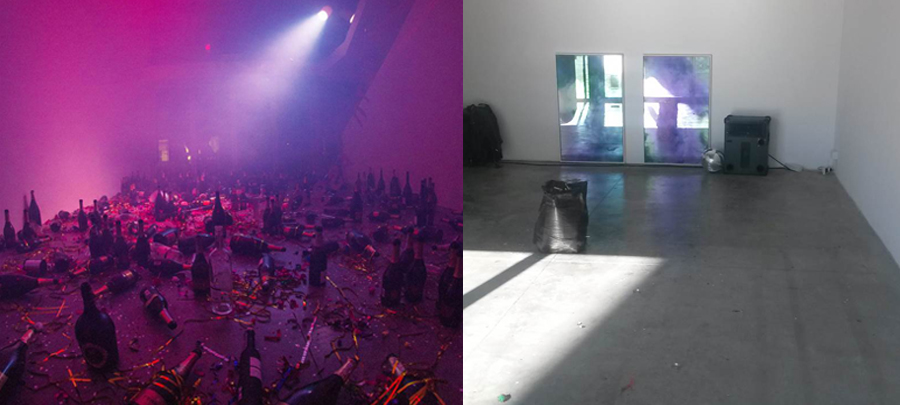I don’t believe we are thinking hard enough about the relationship between art and life. The recent ‘clean-up’ job at the Museion Bolzano and our all too predictable reactions to the incident—both that contemporary art must actually be trash, or, that being trashed necessarily proves contemporary art to be challenging and subversive—reveal the scope of the problem, the scope of our limited thinking. It’s not like the cleaning crew’s actions are akin to rioting after the premier of the Rite. The cleaning crew was told to clean up trash (including empty wine bottles) from a gallery event. They ended up removing an art installation designed to reflect the indulgence and consumption of the 1980s, composed of empty champagne bottles, cigarette butts, confetti, and discarded shoes and clothing, titled “Where shall we go dancing tonight?”. Such a case of mistaken identity makes me laugh and also interests me because it calls into question our more general ability to identify things (and our presumption that what we identify will then remain both true and consistent). But there’s more: the host institution managed to salvage the artwork’s materials, re-install the work using photos of the original, and actively highlight (while apologizing for) the case of mistaken identity through press quotes and social media. Now I am confused. I intuit a truth that those engaged with contemporary art and music continue to back away from.[1]
To begin to think through this confusion and reveal the perspectival truth I intuit, let us first outline a sequence of events regarding the above incident: artists Sara Goldschmied and Eleonora Chiari collected materials to actualize the idea of trash leftover after a party in the ‘80s; with the help of the Museion, they contextualized the materials as Art (ostensibly to reflect/constitute/promote some ideological distance from ‘80s-style consumerism); a cleaning crew mistakenly identified their work as trash; the Museion recovered the materials and re-presented the work as Art in an attempt to definitively reassert that it is, in fact, not trash; and now, the institution is leveraging the affair as a promotional vehicle under the guise of sustaining a public ‘dialog’ on contemporary art. Across these events (and at the risk of perpetuating what I consider to be a wholly farcical dialog), I cannot help but glean the discourse of a larger narrative— namely, our post-modern ‘clean-up’ of the modernist event, whereby any contemporary shock occurs not over what things one places in the gallery (what constitutes art), but rather, in questioning or undermining the juridicial equality of any-Thing’s inclusion (art constituted of anything).
The Larger Imperative
After Duchamp’s readymades and then Cage’s silence, we still seem incapable of thinking past the provocation turned aesthetic end-game of life as Art. Any of our subsequent attempts to undermine the aestheticized frame enframing life have only further highlighted the priority of the frame over its content. But in mistaking the Art of “Where shall we go dancing tonight?” for trash, the Museion cleaning crew plays the ‘part of no-part’ in a much larger drama between art and life, and in that role, I identify a kernel of hope.
Urinating into Duchamp’s Fountain is not a case of mistaken identity, but rather, a next-wave provocation undertaken with full-acknowledgement that the readymade’s “transgressive excess [lost] its shock value and is fully integrated into the established art market.”[2] Such an action only reinforces the epistemological foundations upon which the aestheticization of Duchamp’s attempt to “discourage aesthetics” are built, namely the pursuit of distinction or the recuperation of the marginalized. In contrast, the possibility of mistaken identity or misattribution lurking at the intersection of Art and trash (or Music and noise) is at once innocent and insurmountable, resisting any attempt at universalization in one direction or the other. Ontological determination is, at a base level, entirely contingent; no degree of consensus formation mitigates against the thing becoming something else entirely. Thus, while attempts to undermine consensus can be read as giving voice to marginalized (perspectives, people, etc.), if we subtract any and all ‘attempts’, if the artist truly disappears from the work and leaves nothing but the possibility of perceptual difference as difference, then any case of mistaken identity is devoid of mistake; it is constitutive, regardless of the direction in which identity is resolved.
Accordingly, we should say that Goldschmied’s and Chiari’s mistake lies in their attempt to prevent a re-presentation of ‘80s trash from, in fact, being trash— from preventing the cleaning crew from cleaning it up. In response to the event, the artists were quoted as saying, “What happened was bad. It cannot be possible for an installation to end up in the rubbish bin.”[3] On the contrary, for Art to continue to advance in its relation to life, such a possibility must be foundational.
A Speculative Response
In my view as an electroacoustic composer and digital artist, sound, image, technology, and site, when placed in thoughtful relation, can (and should) be leveraged to advance new possibilities for artistic practice devoid of any necessity to be Art. The absence of necessity can also be stated as the possibility that no Art occurs, and thusly, for the artist to manipulate materials potentially toward the creation of nothing. If this sounds self-defeating or self-undermining… it is. Through the artist’s own subtraction of any personal intentions focused on the refinement of some aesthetic essence, a Barthesian-like death (suicide?) of authorship enables artistic practice itself to be set free— reinvigorating Art with new possibilities for both technical advancement and, ultimately, aesthetic experience. As a composer who accepts the possibility that my work is (or may become) trash, I think we should develop tools, techniques, and contexts of presentation that help us call all kinds of objects into question, to mine mistaken-identity to reveal the inherent and unbridled capacity for things to become other (to change with or without reason) across all manner of situations.
In fact, is this not precisely Badiou’s point in discussing the ‘inaesthetics’ of Duchamp?
Art has to become the trace of its own action. Art must be the place of its taking place. So, the work of art is self-sufficient. We must have art without any artist. Duchamp affirms the impersonality of artistic action. He argues against everything that brings into the becoming of the work the trace of a perceptive passivity.[4]
Perceptual activity is the name of the game, and not the activity of the artist highlighting or defending their own activity. The activity of viewer/listener access should be paramount and free (REALLY free, both as a matter of perception and politics) of any a priori ontological determination.
[1] A similar incident happened with a work by Damian Hirst in 2001. However, rather than taking it as seriously as those involved in the more recent incident have, Hirst was quoted as saying: “Fantastic. Very Funny.” Colin Blackstock, “Cleaner clears up Hirst’s ashtray art,” The Gaurdian, accessed November 1, 2015, http://www.theguardian.com/uk/2001/oct/19/arts.highereducation1
[2] Slavoj Žižek, Less Than Nothing: Hegel and the Shadow of Dialectical Materialism (London: Verso, 2012), 256.
[3] As quoted in, “Modern Art Exhibit Mistaken for Trash and Thrown Away.” New York Post Online, accessed November 1, 2015, http://nypost.com/2015/10/27/modern-art-exhibit-mistaken-for-trash-and-thrown-away/
[4] Alain Badiou, “Some Remarks on Marcel Duchamp,” The Symptom 9 (2008), accessed December 1, 2015, http://www.lacan.com/symptom/?p=39.
© 2015, Sean Peuquet. All rights reserved.
